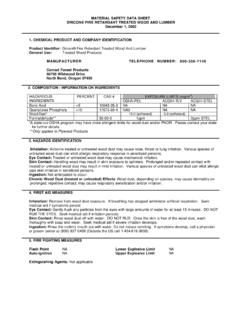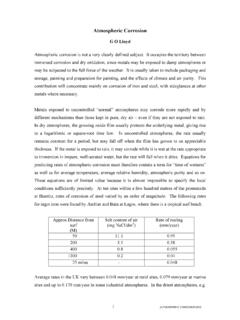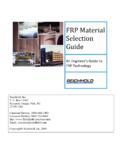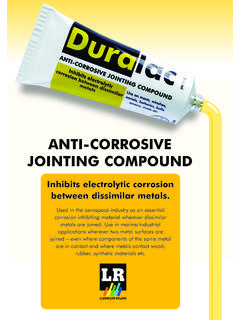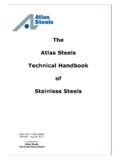Transcription of Tech note – Moldicide Use in Copper Azole Solutions
1 Page 1. C. Technical Note SALES. Title Corrosion and Hardware Recommendations for Treated Wood What affects the choice of hardware for treated wood? Maintaining the structural integrity of the fastener or connector for the intended service life of the structure should be the primary consideration when choosing hardware. Factors commonly affecting the durability of hardware used in contact with treated wood are: The materials comprising the hardware The exposure conditions (moisture, temperature, and air-borne contaminants). The type and retention of treatment used Aesthetic design considerations or special safety or durability requirements may also be important. What is corrosion? Corrosion is a chemical reaction. The primary type of corrosion that occurs with metal hardware on treated wood is dissimilar metal or galvanic corrosion. This type of corrosion occurs whenever different types of metal come in contact in a damp or wet environment.
2 The potential for corrosion of hardware in treated wood occurs when metals in the treatment (such as Copper ) are different from the metals in the hardware (the iron contained in steel or aluminum). The dissimilar metals then create a small electrical current when the wood is damp enough to be conductive, just as in a battery. One of the metals becomes the anode and corrodes faster than it would alone, while the other becomes the cathode and corrodes slower than it would alone. The rate of galvanic corrosion depends on the difference in the electrical potential of the metals, the moisture content (conductivity) of the wood and the temperature. What is the impact of the exposure conditions? Applications such as fresh water or ground contact result in continuously elevated wood moisture content and provide an environment for ongoing corrosion. In above-ground applications such as decking, cyclic wetting and drying will occur.
3 During dry periods when the wood moisture content is under 15 to 17%, the wood has very low electrical conductivity and galvanic corrosion will essentially cease. Corrosion proceeds much more rapidly when temperature is elevated from warm climates or in applications such as roof systems or hot industrial processes. Like all chemical reactions, the corrosion rate can be expected to roughly double for every 20 F increase in temperature. Special consideration needs to be given to air-borne contaminants such as salt near oceans or situations where acids, salts or other chemicals may have much greater impact on fastener corrosion than the wood treatment. What type and retention of treatment was used? The particular combination of treatment and metal hardware can have a major impact on the rate of corrosion. CCA treated wood in outdoor applications has been successfully used for more than 30 years with hot dipped zinc galvanized steel fasteners.
4 However, CCA treated wood in damp environments has never been recommended for use with bare aluminum. Borates, while showing similar corrosion to CCA on unprotected mild steel, have been shown to be less corrosive to galvanized steel hardware. Copper Azole preservatives (dissolved CA-B and CA-C) have a higher level of Copper and show a slight increase in corrosion rates on mild and galvanized steel. Copper Azole preservatives commonly used in the Eastern United States for treatment of pine lumber Hardware Recommendations for Treated Wood Rev. March 28, 2016. ** Recommendations in this Technical Note are solely applicable to treated wood sold in the Americas **. Page 2. (dispersed MCA-B and MCA-C) have corrosion similar to CCA treated wood in contact with various metals. Higher preservative retentions slightly increase corrosion rates. However, this impact is small compared to the impact of continuously wet, salt air or other corrosive environments that wood may be exposed to.
5 The impact of retention on corrosion is smaller for dispersed Copper preservatives than for dissolved Copper preservatives. How can after treatment processing help? After treatment processing may include extended storage or kiln drying. In some preservative systems this allows the Copper to react more fully with the wood, which may lower the potential for corrosion. Drying reduces the wood moisture content which will reduce any initial corrosion. What influence does the type of hardware have? Most structural hardware is made of mild carbon steel. In applications where corrosion may occur, steel is protected with zinc (galvanized) or proprietary coatings. Zinc coatings react in environments that are cyclically wet and dry to form an impervious barrier protecting the steel substrate. The zinc also provides cathodic protection as it preferentially corrodes to protect the underlying steel.
6 Proprietary coatings form a non-reactive and electrically insulating barrier that prevents contact of the wood with the base steel. Non-ferrous metal hardware is used in specialty applications. Copper , Copper alloys, silicon bronze and stainless steel are generally more resistant to corrosion than galvanized steel. Building code fastener and connector requirements The 2015 International Residential Code (IRC) and the 2015 International Building Code (IBC) have similar requirements for fasteners used in treated wood. Both codes require fasteners, including nuts and washers, to be hot-dipped galvanized steel in accordance with ASTM A153, stainless steel, silicon bronze or Copper . Fasteners other than nails, timber rivets, wood screws and lags screws are also permitted to be mechanically deposited zinc coated steel in accordance with ASTM B695, Class 55 minimum.
7 Plain carbon steel fasteners are permitted in borate treatments (SBX, usually disodium octaborate tetrahydrate - DOT) and zinc borate treated wood used in interior environments not exposed to liquid water. The IRC also permits and larger anchor bolts to be non-galvanized steel. The IRC and IBC require connectors used in pressure treated wood in exterior applications to have coating types and weights in accordance with the connector manufacturer's recommendations. In the absence of manufacturer's recommendations, a minimum of ASTM. A653, Type 185 zinc-coated galvanized steel, or equivalent, shall be used. Other code provisions apply to fasteners in preservative treated wood foundation systems and in fire retardant treated wood. There are no specific provisions in the code for flashing used in contact with treated wood (see recommendations below).
8 Fastener, connector and flashing recommendations Metallic fasteners, connectors and flashing that are in contact with each other should be of the same type of metal. Different metals in contact or close proximity in a damp or wet environment will result in galvanic corrosion and may cause premature failure of the fastener, connector or flashing. Nonmetallic flashing may be used in contact with treated wood and metallic fasteners or connectors. Zinc or cadmium electroplated fasteners, connectors and flashing have minimal protection and are not suitable for use in damp or wet environments. They should only be used in dry applications where the use of non-galvanized mild steel is permitted. Galvanized connectors should be inspected to insure that the galvanizing is continuous, of an even appearance, and free from debris. Hardware Recommendations for Treated Wood Rev.
9 March 28, 2016. ** Recommendations in this Technical Note are solely applicable to treated wood sold in the Americas **. Page 3. 304 or 316 stainless steel hardware (or equivalent durability) should be used in severe environments with an unusually high corrosion hazard (such as when continuously wet or subject to salt water splash or spray), in critical architectural applications where appearance is of great importance, in structural applications of an especially critical nature or where an exceptionally long service life is required. The following recommendations are based on the experience of Arch Wood Protection, Inc. and Arch Treatment Technologies, Inc. (collectively, Arch ) and testing of products by these companies. They are general recommendations and may not be suitable for every application. Consideration must always be given to any special conditions, local environments or critical applications.
10 Arch expressly disclaims any liability for outcomes, expenses, losses, claims, or damages resulting from your decision to adopt or to not adopt these recommendations. Important Note: In code applications, the choice of fasteners and connectors should always take into consideration acceptability to the local building inspector or other authority having jurisdiction. The use of mild steel, electroplated galvanized or galvanized steel fasteners and connectors that do not comply with ASTM A153, ASTM B695 Class 55 or ASTM A653 Type 185 is not recognized by building codes for most uses in contact with treated wood. The use of connectors is required to be in accordance with the recommendations of the connector manufacturer. Code requirements may differ somewhat from Arch Wood Protection recommendations show in the table below. Copper Azole , PTI and CCA Treated Wood (1).

